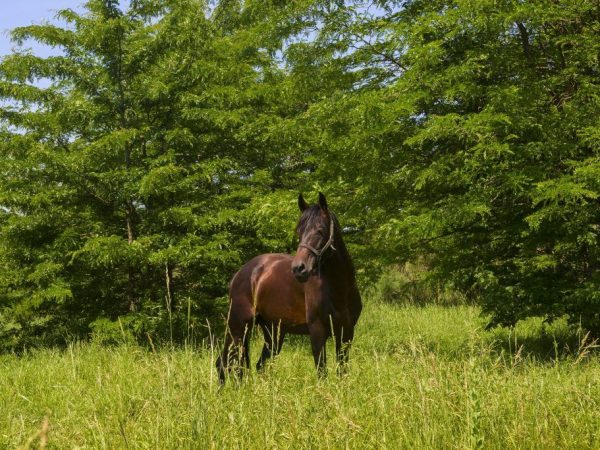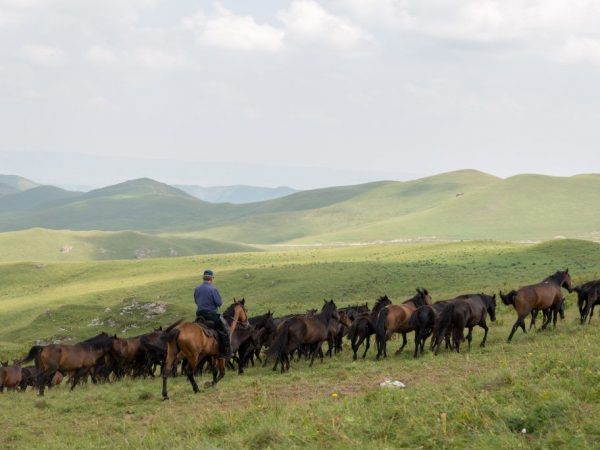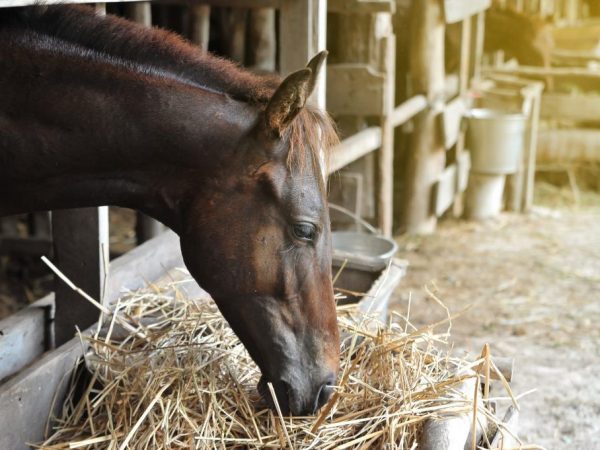Description of horses of the Kabardian breed
The horse has long been used by man for many needs. These animals acted as a labor force in agriculture or as a means of transportation in the field. There are several varieties of horses, the differences between which depend on the area of their use. Some types of horses are good for sport races, some are suitable for the agricultural industry or dressage. The latter include the Kabardian horse breed. These stallions are distinguished by a special body constitution, thanks to which they are indispensable in the highlands and still compete with technology.

Characteristics of horses of the Kabardian breed
History emergence
The Kabardian horse breed was known several hundred years ago. However, the use of horses for military purposes almost led the breed to extinction.
For a long time, this type of horse did not have clearly established standards. The Kabardian horse breed began its official history in 1870. At this time, the Malkinsky stud farm was opened for breeding the breed. In 1930 the Malokarachevsky plant created several breeding lines. In particular, the Karachaev breed of horses was bred, which is mistakenly considered to be the Kabardians.
In the modern world, Kabardians are actively used in Asia Minor for grazing cattle or patrolling borders. Also, some lines are involved in sporting events. At short distances, the Kabardian horse does not show good results, but in long distance races it is the undisputed leader. The Kabardians use these horses for mountain tourism, since a well-worn stallion of this species is very calm about strangers. The Kabardian horse is often found in the photographs of travel booklets in the Caucasus.
Stallion exterior
The appearance of the Kabardian horse breed has distinctive features. There are such signs of the breed:
- Growth reaches 155 cm, and weight - 400 kg.
- The body of the animal is massive, the back is straight and ends in a strong croup.
- The neck is curved and short.
- The head is medium in size, the muzzle is prominent, with a characteristic convex profile and developed nostrils.
- The legs have pronounced joints, the hind limbs are distinguished by a saber shape.
- The hooves are high and firm.
- The average life span of a horse is 35 years.
The unusual structure of the limbs allows this breed to easily perform mountain dressage. In addition, the Kabardian horse breed is often used for long distance races. Thanks to their body constitution, these stallions can overtake well-groomed horses at long distances. A photo of this animal is often found in horse atlases as an example of a balanced breed.

The appearance of the Kabardian breed
A characteristic color for the breed is black, red and karak. There are also motley individuals, but they try not to allow them to divorce and are considered marriage.
The Kabardian breed is also divided into 3 lines:
- Eastern type. These horses were bred for long distance riding.
- Thick or massive type.The stallions of this line are characterized by a powerful body and good traction. They are used in rural work.
- Basic type. Horses of this species combine all the characteristic features of the massive and oriental type.
The nature of the breed
In many ways, the behavior of the Kabardian horse depends on the breed line. So, for the eastern type, such features as rebelliousness and willfulness are characteristic, and the massive look of stallions is distinguished by calmness and endurance.
In the Caucasus, the practice of horse detour is still used. In the early years, stallions are kept in a herd and lead a semi-wild lifestyle. This hardens their character and increases their stamina. By the third year, the stallion begins to go around. Horses are initially reluctant to trust humans and may be aggressive. However, after several dressages, the Kabardian submits to the rider and becomes obedient. The Caucasian peoples use horses in hostilities, therefore, the trust between the rider and the horse must be absolute.

The nature of the horses
The Kabardian is valued for the following qualities:
- Fidelity. Horses become so attached to their owners that they can get sick if the rider changes.
- Courage. This breed is characterized by resistance to loud noises and dangerous situations. Kabardians are not afraid of shots and can calmly take a burning barrier.
- Caution. Stallions carefully choose mountain trails, thus ensuring the safety of both themselves and the rider.
In other countries, this breed is not kept in such strict conditions, but many character traits are preserved even after several generations. Photos of Kabardian horses can be found in foreign publications, since due to its character the horse is popular at the border service.
Conditions of detention
Many stud farms and private farmers still use the herd method of keeping Kabardian horses.
In such conditions, stallions grow more seasoned and know how to look for food for themselves. In addition, the cubs are milk-fed for a long time, which makes them healthier and stronger. In some villages in the Caucasus, the Kabardians are being kept in the stable on a permanent basis only after they have traveled around. This usually happens in the 2-3 year of the horse's life.
Nowadays, breeding horses are mainly kept on pastures, and workers and sports individuals are housed indoors. The Kabardian horse breed does not require special living conditions. The box of one individual should be 4 square meters in size. m, the floor of the stall is covered with a layer of sawdust or straw. If the horse is used for the border guard, no lighting is installed in the stable: such horses are better oriented on the terrain at night.
Among the sanitary standards of the content, the following can be distinguished:
- The stable should be free of drafts, strong odors or loud noises.
- The litter is changed once a day.
- Indoor temperature and humidity levels should be stable regardless of the season.
- The stable should be cleaned completely once a week.
- When the seasons change, the room must be disinfected with special agents.
Pastures for grazing are a mandatory requirement for keeping Kabardians at home. This breed cannot be permanently in the stall. Stallions do not tolerate a lack of physical activity. For the proper development of muscle tissue, the horses should be provided with mountain walks.
Every six months, the entire herd must be examined by a veterinarian. Kabardian horses undergo compulsory vaccination.
Animal diet
The daily food of Kabardians depends on the conditions of detention. If horse breeders use the herd method of raising horses, then the animals get most of the food for themselves on pastures.
These stallions are sometimes fed vegetables and legumes to replenish their vitamins. Also, horses that feed on grazing can be given millet straw and oats.
If the animal spends most of the time in the stable, then the diet of the Kabardian horse should be balanced. Stall keeping allows you to raise larger stallions, however, the main characteristics of the breed are lost.
The daily nutrition of the Kabardian horse, which is kept in the stable, should include the following products:
- Meadow and clover hay - 60% of all feed types.
- Fresh vegetables - 30% of all feed types.
- Concentrates - 10% of all feed types.
- Vitamin and mineral supplements - according to the weight of the horse.

Nutrition of the horse of the Kabardian breed
For better assimilation of grain crops, the feed is crushed and mixed with straw cutting before use. Finely chopped wheat or rye straw increases saliva flow, making it easier for the horse to chew. Before giving vegetables to Kabardians, they should be thoroughly washed and cut into large pieces. To increase milk production, lactating mares can include boiled potatoes and beets in the diet.
The amount of food consumed by a stallion of the Kabardian breed depends on physical activity. If the horse is used as a labor force or in long-distance races, the diet should be as follows:
- Forbs hay - 50% of all feed types.
- Juicy food - 10% of the daily ration.
- Concentrates - 40% of all feed types.
- Vitamin and mineral supplements depending on the proportions of the horse.
Among other things, you need to monitor the quality of products. Mold, under-dried hay, or parasite-tainted vegetables can cause serious gastrointestinal problems. Particular attention should be paid to vitamin supplements. Kabardian horses are often used on long races, so the bone and muscle tissue of the horses should be well developed. To do this, stallions are given the following natural ingredients in complementary foods:
- bone and grass meal;
- fish fat;
- cake.
The stallion of this breed consumes a lot of water - the animal's drinker must hold 50 liters of liquid. Dehydration is deadly for horses: in the absence of water for a long time, the stallion can die or remain disabled.


